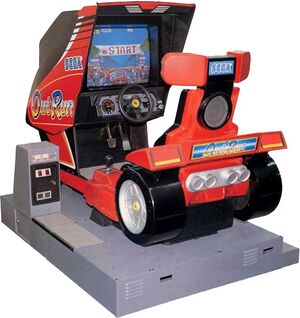Taikan game
From Sega Retro

Taikan games (体感ゲーム), roughly translating to "bodily sensation" or "experience" games, is a term coined by Sega during the 1980s to describe its range of bespoke sit-down or ride-on arcade games which employ moving cabinets. Sega produced a number of very successful taikan games during the decade, starting with 1985's Hang-On and culminating in the early 1990s.
Sega were market leaders when it came to this sort of technology, and most were spearheaded by Yu Suzuki and his team, with the software and hardware being developed by the forerunners to Sega AM2 and Sega AM4, respectively. On the software side, the team improved ideas first put forward by 1981's Turbo by simulating three-dimensional worlds by scaling and rotating 2D sprites at high frame rates, while the hardware (at least in deluxe models) could react to the player's movements, physically rotating left or right (or in the case of the R360 cabinet, rotating in any direction).
With the exception of Thunder Blade which has some overhead segments, all taikan games have the player move "into" the screen at all times. Most of these games were also made available in cheaper, less elaborate sit-down or upright arcade cabinets
Sega themselves stopped producing these style of games with the launch of Virtua Racing in 1992, with the Sega Model 1 and Sega Model 2 arcade boards giving rise to what Sega called the "CG game" - video games created with 3D polygons. Sega's rivals also produced taikan games, such asFinal Lap by Namco and Big Run by Jaleco[1] although are not thought to have referred to them as such.
List of taikan games
- Hang-On (1985)
- Space Harrier (1985)
- Enduro Racer (1986)
- Out Run (1986)
- Super Hang-On (1987)
- After Burner (X Board; 1987)
- After Burner II (X Board; 1987)
- Thunder Blade (X Board; 1987)
- Galaxy Force (Y Board; 1988)
- Galaxy Force II (Y Board; 1988)
- Power Drift (Y Board; 1988)
- Turbo OutRun (1989)
- GP Rider (X Board; 1990)
- AB Cop (X Board; 1990)
- Racing Hero (X Board; 1990)
- G-LOC: Air Battle (Y Board; 1990)
- Limited Edition Hang-On (1991)
- Rad Mobile (System 32; 1991)
- Strike Fighter (Y Board; 1991)